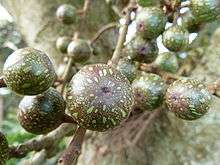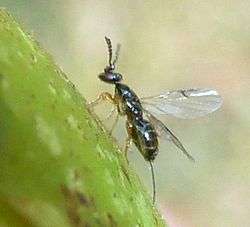Ficus sur
| Cape fig | |
|---|---|
 | |
 | |
| Scientific classification | |
| Kingdom: | Plantae |
| (unranked): | Angiosperms |
| (unranked): | Eudicots |
| (unranked): | Rosids |
| Order: | Rosales |
| Family: | Moraceae |
| Genus: | Ficus |
| Species: | F. sur |
| Binomial name | |
| Ficus sur Forssk. 1775 | |
| Synonyms | |
The Cape fig or Broom cluster fig (Ficus sur)[note 3] is a widespread Afrotropical species of cauliflorous fig. This fast-growing, deciduous[3] or evergreen tree usually reaches 5 to 12 m,[4][5] but may attain a height of 35 m to 40 m.[4][6] Large specimens develop a massive spreading crown,[6] fluted trunks and buttress roots.[3][7] In cooler climes it is coastal, but they may be found at up to 2,500 m altitude.[1][4][7] The heavily clustered figs suggest fecundity, and some trees in East Africa have been venerated as sacred shrines in animist practices.[5] Over its extensive range it is variable with respect to leaf shape, texture of the leaves and figs,[1] deciduousness and overall size.
Range
It is found from Cape Verde and Senegambia across tropical West Africa to Cameroon and the Central African Republic. Eastwards it is found in Eritrea, northern Somalia and Yemen, and southwards to all African countries except Lesotho and the dry interior regions of Botswana, Namibia and South Africa.[4] It is found in forests or grassy woodlands,[5] and occurs at higher densities in well-watered, temperate uplands. It is absent or outnumbered at lower, warmer climes by the similarly cauliflorous species, F. sycomorus.
Description
The large, alternate and spirally arranged leaves are ovate to elliptic with irregularly serrated margins.[7] Fresh foliage is a conspicuous red colour and the papery, 1 cm long stipules are soon dropped.[5] The bark of younger trees is smooth and pale greyish-white in colour, in contrast to the flaky, yellow bark of F. sycomorus. With increasing age the bark becomes darker and rough.[3]
The figs are carried on short or long drooping spurs (or fascicles) which may emerge from surface roots, the trunk or especially from lower main branches.[1][5][6] The figs are 2 to 4 cm in diameter[1][8] and acquire a rosy, speckled exterior when ripe.
Uses
The wood is light and soft and is not much used commercially. All parts may exude a latex, which has some traditional medicinal applications.[5] The latex has been shown to contain ursene and oleanane triterpenoids,[9] of which the latter may be effective in cancer treatment,[10] while a methanolic extract from the roots is potentially effective against chloroquine-resistant malaria.[10] The figs are edible and utilized in fresh or dried form by native people in many regions. They are also suited to preparation of fig preserve,[6] if other suitable fruit are added.[5]
Species associations

Lepidopteran larvae of the African map butterfly,[7] Fig tree moth,[11] Accented hawk moth,[7] Specious tiger,[8] Common fig-tree blue[8] and Lesser fig-tree blue[8] feed on the leaves or roots of this species.
Pollination is performed by three species of Ceratosolen wasp.[8][12][13] The Ceratosolen wasps are parasitised by Apocrypta guineensis and Sycoscapter niger wasps during their larval development inside the flower galls. As of 2006, 19 species of fig wasp were known to associate with the Cape fig, these belonging to genera Acophila, Apocrypta, Apocryptophagus, Ceratosolen, Eukoebelea, Idarnes, Sycomacophila, Sycophaga, Sycophila, Sycoscapter and Watshamiella.[13] The Afrotropical fig wasp fauna is however poorly known.[13]
The fig seeds are dispersed after passing through the intestinal tracts of birds, bats and primates.[6][8]
Gallery
 Fresh foliage tended by Argentine ants
Fresh foliage tended by Argentine ants Drooping paniculate spurs with fig clusters
Drooping paniculate spurs with fig clusters Ceratosolen capensis adult, a pollinating wasp
Ceratosolen capensis adult, a pollinating wasp Apocrypta guineensis wasps, parasitoids of C. capensis larvae
Apocrypta guineensis wasps, parasitoids of C. capensis larvae
Notes
- ↑ The presence of two stamens per flower, rather than one, was found to be an inconsistent characteristic, see: Aweke, Getachew (1979). "A Revision of the Genus Ficus in Ethiopia". Meded. Landb. Wag. 793 (66).
- ↑ A subtropical form with shaggy figs that ranges from Tanzania to northern South Africa, cf. Berg, C.C. (1991) and Palmer, Eve (1977). A Field Guide to the Trees of Southern Africa. London, Johannesburg: Collins. pp. 91–92. ISBN 0-620-05468-9.
- ↑ The etymology of the specific name is unclear. It may be of Arabic origin and suggest Sur, Oman, where it is not native.
References
| Wikimedia Commons has media related to Ficus sur. |
- 1 2 3 4 5 Berg, C.C. (1991). "Moraceae: Ficus sur Forssk.". Flora Zambesiaca. 9 (6). Retrieved 3 January 2013.
- ↑ "Ficus sur Forssk., Synonyms". ThePlantList. Retrieved 31 December 2012.
- 1 2 3 Von Breitenbach, F. (1985). Southern Cape Tree Guide. Pretoria: Dept. of Environment Affairs: Forestry. ISBN 0-621-09741-1.
- 1 2 3 4 "Ficus sur Forssk.". African Plant Database. CJB & SANBI. Retrieved 1 January 2013.
- 1 2 3 4 5 6 7 Palgrave, K.C. (1984). Trees of Southern Africa. Cape Town: Struik. p. 105. ISBN 0-86977-081-0.
- 1 2 3 4 5 Hankey, Andrew (2003). "Ficus sur". Plants of SA. plantzafrica.com. Retrieved 31 December 2012.
- 1 2 3 4 5 "Ficus sur Forssk.". Flora of Zimbabwe. Retrieved 31 December 2012.
- 1 2 3 4 5 6 Van Noort; et al. "Ficus sur Forsskål 1775". Figweb. iziko museums. Retrieved 31 December 2012.
- ↑ Feleke, Sisay; Brehane, Abeba (2005). "Triterpene compounds from the latex of Ficus sur I.". Bull. Chem. Soc. Ethiop. 19 (2): 307–310. ISSN 1011-3924.
- 1 2 Lansky, E.P., Paavilainen, H.M. (2011). Figs: The Genus Ficus. CRC Press. pp. 222, 230, 298. ISBN 978-1-4200-8967-7.
- ↑ Goff, Roy. "Naroma varipes, (Walker, 1865)". African Moths. Retrieved 21 January 2013.
- ↑ Van Noort; et al. "Ceratosolen capensis Grandi". Figweb. iziko museums. Retrieved 1 January 2012.
- 1 2 3 Van Noort, Simon; Van Harten, Antonius (2006-12-18). "The species richness of fig wasps (Hymenoptera: Chalcidoidea: Agaonidae, Pteromalidae) in Yemen". Fauna of Arabia (22): 449–472. Retrieved 1 January 2013.